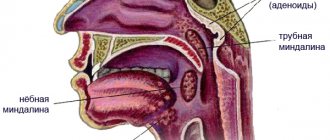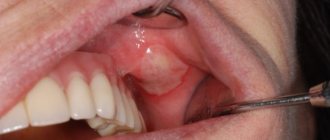Holes in the tonsils: what are they?
Normally, in a healthy person, the tonsils are structured like a porous sponge and contain approximately 20 depressions (lacunae), which are designed to contain pathogens.
During illness, this first line defense mechanism prevents the infection from progressing further. Microbes settle in the gaps - clots of white or yellow pus become noticeable on the tonsils; by the way, these are the only tonsils in the body that you can see for yourself.
This organ has the ability to recover on its own and after treatment, the tonsils take on their previous appearance, becoming whole, dense, covered with pale pink mucous.
Holes in the tonsils: photo
In the case of frequent illnesses, complications, or reduced immunity, this process is disrupted and the lacunae are closed with degenerated lymphatic tissue, which visually looks like holes in the palatine tonsils. These holes become collections for food debris, bacteria, and dead epithelial cells, which form purulent plugs.
When asked what kind of holes are in the tonsils, the doctor diagnoses the patient with chronic tonsillitis.
Prevention
To ensure that medication treatment and rinsing do not have to be repeated, simple rules of oral hygiene should be followed.
- It is important to brush your teeth regularly in the morning and evening to remove food debris. After each meal, you need to rinse your mouth with plain water or a special solution.
- It is also recommended to review your daily routine, give up bad habits and take measures to improve your immunity.
- It is advised to think through your wardrobe so as not to overcool, provoking the proliferation of pathological bacteria.
Holes in the tonsils appear due to certain diseases and weakening of the body's protective functions. They can also in turn become the source of numerous health problems. If pits are detected on the tonsils, it is important to consult a physician to undergo diagnosis and treatment.
What are the symptoms?
In addition to visual identification, holes in the tonsils are accompanied by other symptoms that should alert you. These include:
- swelling of the palatine tonsils;
- sensation of a foreign body in the throat;
- discomfort when swallowing, inability to perform a full act of swallowing;
- expectoration of white lumps (caseous plugs);
- foul breath that cannot be masked by anything;
- elevated body temperature (sometimes).
Together, these symptoms indicate the development of an inflammatory process in the throat.
Causes of holes in tonsils
Holes in the tonsils cannot just happen. Their appearance means an active increase in lymphocytes (the body's defenders), in tissue cells that begin to divide and grow.
As a result, the tonsils acquire a loose, deformed structure. The reasons why holes remain after traffic jams include:
- bacterial infections. Due to the proliferation of microbes, the lymphatic tissue of the tonsils becomes swollen, which leads to the expansion of natural lacunae;
- rehabilitation period after illness. The tonsils need some time to recover in size after suffering a viral disease;
- frequent hypothermia;
- enlarged nasopharyngeal tonsils (adenoids). This pathology is accompanied by a chronic inflammatory process;
- inflammation of the maxillary sinuses, which is characterized by the accumulation of large amounts of pus;
- dental diseases;
- dental infections of the oral cavity – stomatitis, inflammation of the tongue, gingivitis;
- congenital or acquired deformation of the nasal septum.
When the throat hurts very badly and holes in the tonsils, which are filled with pus, appear as a result of lacunar tonsillitis.
All these factors significantly reduce the body’s defenses, as a result of which the tonsils, being the center of attack of pathogenic bacteria, become deformed.
The structure of the tonsils and their number
Tonsils or otherwise tonsils consist of lymphoepithelial porous tissue. They are located in the nasopharynx in a circle and are part of the Pirogov-Waldeyer (pharyngeal-lymphatic) ring.
They are divided into paired and unpaired, there are 6 of them in total. The first group includes:
- Palatal. They are located on both sides of the pharynx in a depression formed by the tongue and soft palate.
- Pipe. Located next to the auditory tube.
Unpaired formations:
- Pharyngeal or nasopharyngeal. Located on the posterior fornix of the pharynx.
- Lingual. The location is the back of the root of the tongue.
Functions of the tonsils:
- Barrier. They trap and neutralize bacteria and viruses.
- Immunogenic. B and T lymphocytes are formed in the follicles of the tonsils.
- Hematopoietic. Active during the neonatal period.
- Enzymatic. The tissues of the organs secrete some enzymes necessary for the initial stage of digestion in the oral cavity.
The tonsils are also involved in the formation of voice timbre, so their defeat leads to hoarseness.
Do I need to see a doctor?
If, with the help of a mirror, a hole was discovered in the tonsil, and there is pus inside, this is a serious reason to consult a doctor, since in this way only a small part of the inflammatory process can be seen.
Moreover, it is categorically impossible to remove these accumulations of pus on your own - even the slightest damage to the lymphoid tissue can provoke the spread of infection throughout the body, including blood poisoning.
Cases where there are holes in the tonsils, but they are without pus, should not be ignored by doctors either. The presence of such a deformation indicates the absence of a natural barrier to infections and is a favorable environment for the free proliferation of pathogenic microbes.
First, you can seek help from a general practitioner, who, if necessary, will refer the patient to specialized specialists - an otolaryngologist or an ENT surgeon.
Methods for diagnosing pathology
At the appointment, the doctor examines the tonsils using a laryngeal mirror, a magnifying glass and a light source, collects anamnesis, and states the general condition.
Additionally, he examines the nasal cavity and auditory canals. To make a diagnosis and identify concomitant diseases, the doctor gives directions for laboratory and diagnostic tests:
- General and biochemical blood test. Indicators of the levels of red blood cells, leukocytes and platelets will help determine the presence of an inflammatory process or any neoplasms;
- general urine analysis. Necessary for detecting pathological processes in the body that reduce immunity and worsen the patient’s condition;
- smear for bacterial culture. Epithelial cells of the pharynx will help determine the type of pathogenic organisms, which will help in choosing the right therapeutic tactics.
Bacterial studies are carried out with a button probe, which is inserted to determine the presence of adhesions characteristic of chronic tonsillitis.
If a malignant neoplasm is suspected, a biopsy of the lymphoid tissue of the throat is performed.
Treatment methods
You can get rid of holes in the tonsils filled with pus only by eliminating the true cause of the inflammatory process. Self-medication in such cases is contraindicated, since only an experienced doctor will be able to provide complex therapy, minimizing serious complications.
Taking antibiotics
When pus accumulates in the lacunae, broad-spectrum antibacterial drugs are used, which not only inhibit the proliferation of bacteria, but also completely destroy them. Depending on the type of pathogenic pathogens, drugs such as Azithromycin, Tsiprolet, Amoxicillin are prescribed.
Washing tonsils in the ENT office
To clean them of purulent plugs, a syringe with a special attachment is used, which directs the disinfectant composition directly into the lacunae. A jet under pressure knocks out the plugs, and the tonsils are cleared. For full results, at least 15 sessions are required.
Vacuum lavage of the tonsils is carried out under local anesthesia using a device. A special nozzle is attached to the tonsil, and the purulent contents are sucked out through it. The tonsils are then treated with an antiseptic to prevent relapse.
Another device, Tonsilor, is actively used by doctors to treat purulent tonsils. The impact on the tonsils is carried out using ultrasound and vibrations transmitted by a special attachment. When the purulent plug becomes pliable, it is washed out with a medicinal solution, which is delivered in a strong stream.
Physiotherapy
The most popular and effective procedures are using:
- ultraviolet rays, which have a powerful antibacterial effect;
- laser, which activates blood and lymph flow in the tonsils, relieves inflammation;
- ultrasound, with the help of which medications penetrate deep into the tissue of the tonsils.
Also, throughout the entire treatment, the doctor prescribes rinsing the mouth and throat with antiseptic solutions (Furacilin, Miramistin), taking immunostimulating drugs, and vitamin complexes.
Removing traffic jams
Antibacterial therapy is supplemented with the use of local disinfectants. The holes in the tonsils are often clogged with accumulations of food debris, leading to plugs. In order to clean the lacunae, it is necessary to rinse the throat with antiseptic solutions.
This procedure is carried out in a clinic setting. To rinse the throat, use a special large syringe. An antiseptic solution is poured into it. The jet is directed directly into the lacuna filled with purulent contents. Under liquid pressure, the plug is washed out. To completely cleanse the tonsils, about 10 - 15 such procedures are required.
Large plugs are pre-softened by ultrasound. To do this, use the Tonsilor device. Then carry out the usual rinsing of the throat with an antiseptic from a syringe.
There are cases when plugs sit deep in the lacuna and are difficult to wash out. Vacuum cleaning helps remove such deposits. For this purpose, a device with a special attachment is used to pump out pus from the recess in the tonsils.
Only a specialist can remove plugs. At home, only gargling with decoctions of medicinal herbs (chamomile, calendula, sage) or antiseptic solutions (Miramistina, Furacilina) is allowed. This helps reduce inflammation of the tonsils and clear the tissues of food debris.
How to treat at home?
Trying to remove purulent plugs at home is not worth it because of the huge risk of complications. However, for disinfection and strengthening local immunity, traditional medicine recipes can be useful. Suitable for rinsing:
- decoction of onion peels. It must be washed, poured with a small amount of water, brought to a boil and simmered over low heat for 5-7 minutes. Then let the broth brew for at least 3 hours. Use warm;
- beet juice. The root vegetable, crushed in a blender, is sprinkled with table vinegar and left on the table for several hours. Then the juice is squeezed out of the grounds and gargled with it;
- herbal infusion. Pour dry raw materials of chamomile, calendula and plantain into a thermos, pour boiling water over everything and leave to steep for several hours. Gargle after every meal;
- soda-salt solution. Dissolve a teaspoon of salt and soda in a glass of water, mix and use several times a day. The solution has a powerful antiseptic effect.
Rinsing should be done with your head thrown back so that the medicinal composition affects the tonsils as far as possible. The duration of each rinse should be at least 20 seconds.
Use of folk remedies
Traditional recipes should not replace the main therapy prescribed by a doctor. They can speed up the healing process, improve immunity and reduce the severity of negative symptoms.
The following products have proven their effectiveness:
- rinsing with onion broth,
- treating the hole in the tonsils with beet juice,
- soda with salt,
- chamomile decoction.
It is necessary to treat holes in the tonsils using both traditional and medicinal methods at the same time. This way you can quickly achieve improvements.
What can be dangerous: possible complications
If tonsils with holes are ignored, the consequences can be very serious and even life-threatening. It's all about the high risk of infection getting from purulent lacunae into the blood. This can cause the following complications:
- cystitis;
- inflammatory process in the kidneys;
- persistent sore throat;
- toothache;
- pathological processes in the nasopharynx;
- inflammation of the respiratory tract;
- problems with the gastrointestinal tract;
- meningitis.
Purulent tonsils, as a constant source of infection, are very dangerous due to their close connection with the digestive, respiratory and circulatory systems.
Untimely and incorrect treatment can lead to an increase in the number of holes in the tonsils and an increase in the inflammatory process. [ads-pc-1][ads-mob-1]
Oral antibiotics
How to treat holes in tonsils? Enlargement of lacunae is always associated with an inflammatory process of infectious etiology. Therefore, it is necessary to carry out antibacterial therapy. Antibiotics are prescribed that act on a wide range of pathogens:
- "Amoxiclav";
- "Amoxicillin";
- "Tsiprolet";
- Azithromycin.
However, many bacteria have now become resistant to traditional drugs. Therefore, before drug therapy, it is recommended to take a test for the sensitivity of the pathogen to antibiotics. This will help you choose the most effective drug.
When is surgery needed? Surgical removal
Removal surgery is needed only if their tissues are irreversibly atrophied, and constant sore throats seriously undermine the body. The surgical procedure is performed under local anesthesia or general anesthesia and gets rid of caseous plugs forever. Rehabilitation takes place in a hospital under the supervision of a doctor and takes up to 6 days.
Another method of removing tonsils is cryodestruction. When exposed to low temperatures with the help of liquid nitrogen, the tonsils are completely destroyed. The procedure is performed under local anesthesia and takes only a few minutes. Hospitalization after manipulation is not required.
More on the topic: White spots on the throat: causes and treatment. If they don't pass
How to treat purulent plugs in the throat? Causes of formation and symptoms










